 |
|||
 |
 |
 |
||
|---|---|---|
 |
||
 |
||
 |
||
 |
||
 |
 |
 |
 |
Current APR for Home Refinance: What You Need to KnowWhen considering refinancing your home, understanding the current APR for home refinance is crucial. The Annual Percentage Rate (APR) encompasses the interest rate and other costs associated with the loan, providing a more comprehensive picture of what you'll pay over time. Understanding APR and Its ComponentsThe APR includes various components that can affect your refinancing decision. It's not just about the interest rate, but also fees and other charges. Interest Rate vs. APRWhile the interest rate represents the cost of borrowing, the APR includes additional fees such as mortgage insurance, most closing costs, and loan origination fees. Factors Affecting APR
Common Mistakes to AvoidRefinancing can be financially beneficial, but there are pitfalls to avoid. Ignoring the Total CostsMany homeowners focus solely on the monthly payment without considering the total cost of the loan over time. Not Shopping AroundFailing to compare offers can lead to missing out on better rates. It's important to explore different lenders and products, including those offering stated income refinance rates for potentially better terms. Types of Refinance LoansUnderstanding the various types of refinance loans available can help you make an informed decision. Rate and Term RefinanceThis is the most common type, aiming to reduce the interest rate or alter the loan term. Cash-Out RefinanceAllows homeowners to convert home equity into cash, often for large expenses or debt consolidation. Streamline RefinanceDesigned for those with existing government-backed loans, a streamline refinance meaning typically involves less paperwork and faster processing. FAQ Section
https://www.investopedia.com/today-s-mortgage-refinance-rates-by-state-jan-2-2025-8768295
The national average for 30-year refinance mortgages climbed 3 basis points Tuesday to 7.11%, ending a three-day decline. The current average ... https://www.discover.com/home-loans/rates/refinance-rates/
Refinance Rates Today - Term Length Options: - Rate Range: - 30-Year Fixed Rate - 7.00% - 8.55% APR - 20-Year Fixed Rate - 7.00% - 8.55% APR - 15-Year Fixed Rate ... https://www.rocketmortgage.com/mortgage-rates
Today's Rocket Mortgage Rates ; 30-Year Fixed - 7.25% - 7.577% ; 20-Year Fixed - 7.25% - 7.674% ; 30-Year FHA - 6.625% - 7.523% ; 30-Year Jumbo Fixed - 6.25% - 6.48% ; 30- ...
|
|---|